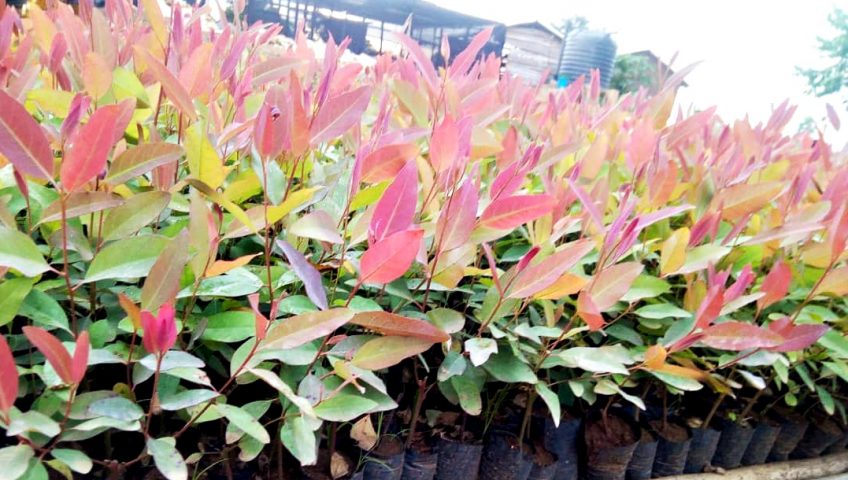SDG01-Poverty eradication, building shared prosperity and promoting equality, SDG02 – Sustainable agriculture, food security and nutrition
Agriculture/Agroforestry, Trees, Small Farmers, Land Degradation, Land Rehabilitation, Biodiversity
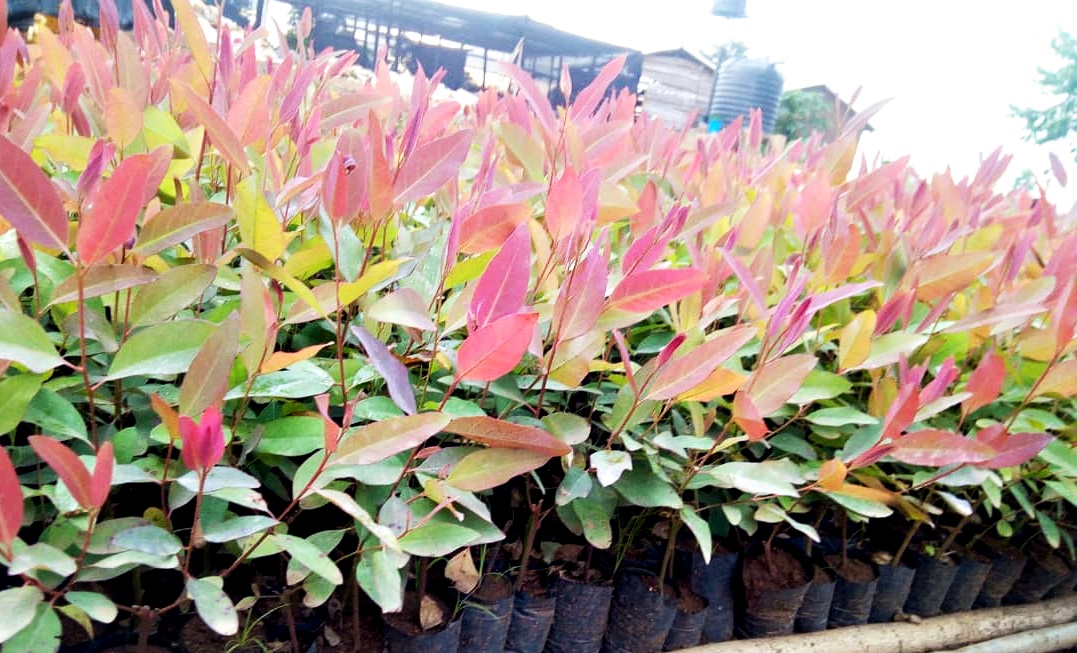
Growing trees is one of the cheapest and easiest nature-based solutions to restore land. Uganda’s successful support of large-scale tree plantations has reaped benefits for the country and larger-scale farmers but fully restoring Uganda’s degraded land and meeting national and international targets needs to include smallholders. Clement Okia and Phillip Kihumuro of World Agroforestry explained to Agroforestry World how this can be done.
BACKGROUND
Scientists recently calculated that growing billions of trees was the cheapest and easiest way to address the climate crisis, removing up to two-thirds of the carbon that had been added to the atmosphere by human activity, even though they only estimated the effect of trees grown on forest land not on agricultural land. The Guardian’s headline for the story it ran on the study made plain the significance of the research: ‘Tree planting “has mind-blowing potential” to tackle climate crisis’.
Yet, according to research conducted by Robert Zomer and team of World Agroforestry (ICRAF), about half of all agricultural land in the world now has greater than 10% tree cover. If those figures were increased, the contribution to mitigating the climate crisis would be significant. And there would be many other benefits, including a reduction in the huge amount of unproductive, degraded agricultural and forest land and a concomitant increase in biodiversity, especially, the all-important group of pollinators upon which our food supply depends.
However, in most countries there are a complex web of reasons why more trees are not being grown on farms. The ICRAF team in Uganda has been examining the complexities in a tree-growing program funded by the European Union, Norwegian Agency for Development Cooperation and the Government of Uganda that encouraged the private sector to engage in pole and timber production. The Sawlog Production Grant Scheme is now in its third phase and is being implemented by the Food and Agriculture Organization of the United Nations (FAO) and the Government.
Before its inception in 2004, the partners in the Scheme had already quantified the supply gap in poles and timber. When the Scheme began, it provided incentives to the private sector to fill the gap by growing more trees.
One of the outputs was a certification scheme for nurseries to ensure that high-quality seeds and seedlings were being produced because these are the backbone of a successful growing program. The problem is that the certification scheme only applied to large nurseries producing a small variety of exotic species for medium- and large-sized plantations; nurseries that catered for mixed tree species used by the majority of smallholders were not included.
Agroforestry World asked Clement Okia and Phillip Kihumuro of World Agroforestry (ICRAF) Uganda about what they had found when looking at the Scheme and what needed to be done to ensure that this already successful investment of the Government and its partners could be applied to smaller nurseries in support of more biodiversity-friendly and inclusive timber and pole value chains.
Typically, the two researchers’ ambitions were much greater: they are calling for a transformation of the sector to empower smallholders to grow more trees throughout the nation.
INTERVIEW
Agroforestry World: We’re curious to know about this highly successful scheme and what model you have in mind to expand its scale to include smallholders across Uganda. It seems like something the world should know about.
Saw-log Production Grant Scheme
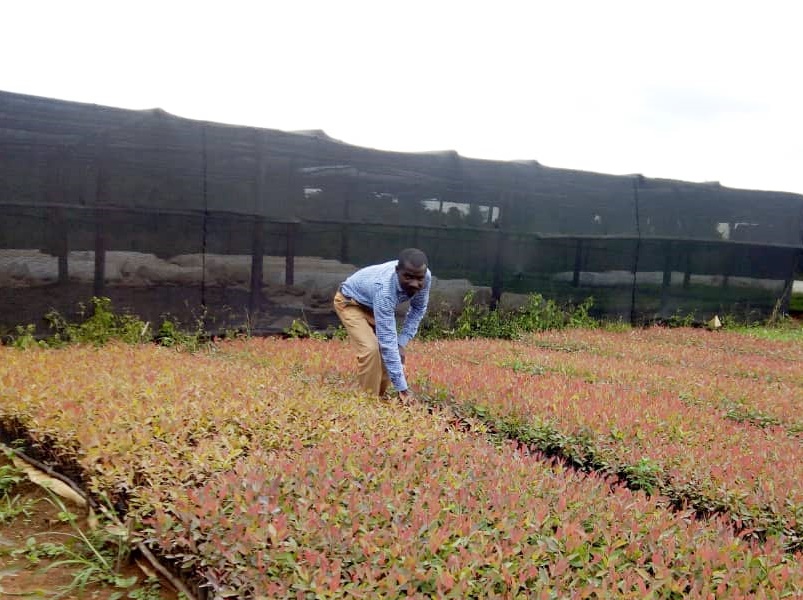
Clement Okia: The background is that the Government of Uganda in collaboration with other partners found that there were huge gaps when they conducted an analysis of the wood resources in Uganda. It was discovered that if no intervention was made then there would be a serious deficit of poles and timber in the near future. That was in the early 2000s. What was decided was to create the Saw-log Production Grant Scheme.
They had to first identify the land where trees were to be grown in plantations and woodlots, including the Government’s designated Central Forest Reserves that had been degraded as people had encroached.
It was agreed that this type of land could be leased to people who were interested in growing trees for a period of about 25 years. They could apply for this land through the National Forestry Authority. Once someone obtained land, they had to commit to proper forestry management practices based on the Scheme’s standards. The Government put together a grants program to encourage people to plant trees because it was considered that growing trees was a long-term and expensive enterprise. They calculated how much would be required to establish one hectare of trees and maintain them during initial stages.
However, there weren’t enough quality tree seeds in Uganda. In the 1970s, the Forest Department had established stands of exotic trees that were suitable for Ugandan conditions, like pine, eucalyptus and other timber species. But because of mismanagement most of these stands were destroyed.
The intervention included bringing in quality seeds from Australia, Brazil and South Africa. People were also trained and certified from one up to five stars to produce tree seedlings. They were monitored once or twice a year to ensure they were meeting the standards for producing high-quality tree seedlings. But this was limited to the few species for plantations and large woodlots, especially the fast-growing exotics, although later they added a few indigenous species. The nurseries were graded, the operators were trained and checked, and the nurseries were continuously monitored to ensure they did produce high-quality tree seedlings.
Anyone who had been granted use of land under the Scheme had to develop a management plan. You were not given the money up front. When you established a woodlot or a plantation, they trained your team and afterwards they gave you back half of the money you used for establishing your plantation. Progress was to be monitored regularly and payments made in instalments until by two years you had been paid half the cost of establishment. That was the incentive to grow trees.
It ended up that most of the people who went into this were those who already had money because the minimum area required to qualify for the Scheme at the beginning was very high: 25 hectares. Local, low-income people complained that all the forest reserves had been taken by well-to-do people and they were not benefitting. So, the Government began to grant a minimum of five hectares to people living around forest reserves on which they could also establish a woodlot. But what happened was that the local people had little motivation to grow trees due to the long-term nature and resources required. They used the land instead to grow crops. In most cases they ended up losing the land after a certain time because they were not fulfilling the objective.
The Scheme moved from phase one to phase two and is now in phase three. In the first two phases, management was under the Forest Sector Support Department of the Ministry of Water and Environment but in phase three it was shifted under FAO Uganda, who work closely with the Department and the National Forestry Authority to implement it.
Overall, the Scheme has been observed to be very successful. The standards of the plantations and woodlots are high and some of them are now producing timber and poles that has been marketed. There are calls to lift a ban on timber export so that the large plantation operators can gain access to regional and international markets. I was the chair of the Uganda Standard Development Group that developed the Uganda National Forest Stewardship Standard based on the Forest Stewardship Council’s scheme. This came into effect in 2018. It helped to domesticate the international generic indicators used for forest certification to local circumstances in Uganda, thus, facilitating adoption of the Council’s certification scheme with the Government’s support. We also piloted group certification for smallholder tree growers that has since been promoted by the Uganda Timber Growers Association. Now, local people with 25, 50, up to 100 hectares can also opt for certification using the group approach. We have made good progress and are championing forest certification as a tool towards sustainable forest management.
Agroforestry World: What is the issue with the nurseries?
Clement Okia: The nurseries have been producing a limited number of species that are certified and high quality. The problem is that in Uganda we have only one national tree seed centre, which is based in Kampala. People in other parts of the country don’t have places where they can obtain high-quality tree seeds. Most of the private nurseries collect their own seeds and are not collecting from the minimum number of trees required to maintain genetic diversity. Most of the farmers obtain their seedlings from roadside nurseries that are not certified. The smallholder is not assured of quality and there is limited availability of high-quality local trees or other species. We run the risk of creating large monocultures that do not integrate other trees, which limits biodiversity and increases the risk of massive losses from pests and diseases and climate extremes. Due to the long-term nature of growing trees, it’s costly to make the wrong decisions in the initial stages.
Phillip Kihumuro: Recently, the Government began moving towards growing energy crops. They have been leasing land to grow trees for fuelwood and biomass. It would be interesting to look for species that would be suitable for that and promote them through the nursery system.
Expanding the Scheme to smallholders
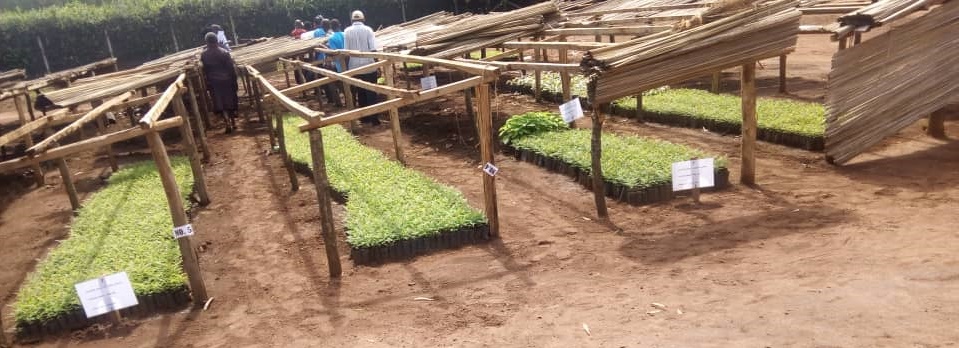
Agroforestry World: What policy gaps do you see that are stopping smallholders from growing more indigenous and mixed species — basically, diverse agroforestry systems — not only for timber and energy but for other benefits as well, like fruit trees? Is that part of your thinking? What’s the design you have in mind for expansion and diversification of nurseries throughout the country?
Clement Okia: Just to return to the lease period for a moment, the Government does not restrict which trees you can grow. They are open to both indigenous and exotic species but exotics bring in quick cash so private investors turned away from indigenous species and went full scale with exotics.
The strategy we are thinking of is based on the observation that the commercial tree-growing aspect seems to be well taken care of through the grants scheme and also the National Forest Authority that is supporting people with training etcetera. But encouraging a larger number of people in the country to grow different trees is not taken care of because when the forest sector in Uganda was realigned in the 2000s, they decided that the National Forestry Authority takes care of the Central Forest Reserves and that the District Forest Services are supposed to support communities to grow trees. This latter is supposed to be funded by local governments. But this is the least-funded sector in the Government structure.
To expand the Scheme to more Ugandans, the Government could replicate the support that was given to large-scale operators to promote growing of trees at local levels through the District Forest Services; decentralize the National Tree Seed Centre, maybe to the regional or district levels; and build the capacity of the District Forest Services to support communities to grow trees.
The Government could also develop tree nursery standards or guidelines that broadly focus on both indigenous and exotics. Anyone running a nursery would need to adhere to them. There could be different categories of nurseries and there could be specific guidelines on how to acquire seeds, identification of the sources of the seeds, and also guidelines for different species — such as exotic and indigenous trees — so that people in different parts of the country could understand the quality and speciality of a particular nursery.
The Forest Sector Support Department should have the responsibility of preparing the nursery guidelines or standards. It should also put in place a mechanism on how these nurseries are monitored and verified. If they don’t have the capacity to do this — even though they are mandated by law — they could find ways of working through other Government entities, such as the National Forest Authority and District Forest Services. For supporting people to grow trees, there is already a Government program called Community Tree Growing. What they have done is that the Government allocates funds to the National Forestry Authority to raise tree seedlings in its nurseries which can be accessed by community groups and individuals through an application process. This is a well-intended program but it’s not achieving its objectives because politicians and other well-placed individuals apply for seedlings, pick a large number of seedlings and distribute in their localities as a form of patronage. No one is responsible for how the planting is to be done and nobody follows up. Supporting tree growing should not be limited to raising and distributing tree seedlings but should proactively engage the community.
The Government could still use this model but we recommend it should include a well-thought-out plan to guide the planting and management of the trees, especially in their early years. It could be decentralized to a lower level, such as districts or sub-counties, and include training farmers in how to plant and manage the seedlings, monitor the survival rate and other important technical matters that make the difference between success and failure. That should be the approach.
The Uganda National Forestry and Tree Planting Act of 2003 recommended establishment of a National Tree Fund to support community tree growing. Up until now, that Fund has not been set up. It is timely that the Fund is operationalised to support widespread tree growing to achieve the country’s ambitious forest and landscape restoration targets of 2.5 million hectares by 2030.
Apart from forest trees, fruit trees are another category that the Government has given attention. There is one fruit processing factory that has been established in eastern Uganda but its operating below its capacity because fruit supply is too low. The Government, through another program called Operation Wealth Creation, procures fruit-tree seedlings and distributes them to different parts of the country but with a special focus on eastern and northern Uganda. But there is limited regard on which mango or orange varieties could grow well in different regions. The planting specifications need to be followed by farmers with support from sub-county extension teams. These are the sorts of things that could be specified in the guidelines or standard and implemented on the ground.
Our view is that the production of planting materials for fruit trees should be decentralized to regional or district levels so that unsuitable seedlings are not planted and so that seedlings are not transported over long distances nor delivered at the wrong time.
When the capacity of the District Forest Services — or other organizations, if that is preferred — has been enhanced, they could play a supervisory role.
Management for timber, food security, livelihoods and biodiversity
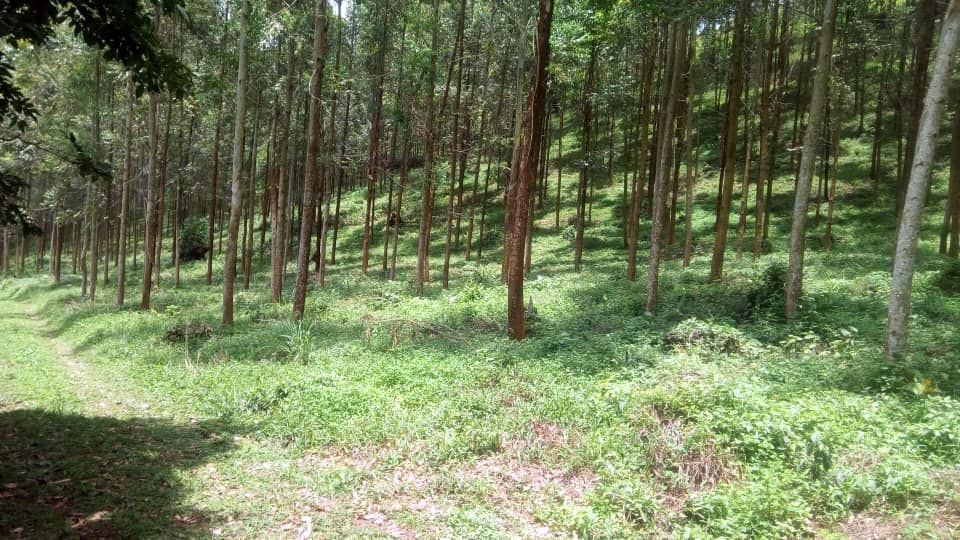
Agroforestry World: Would this include capacity building in tree management, at least for the first few years?
Clement Okia: Yes, tree management needs to be considered seriously. There has been a discussion in Uganda that agroforestry is mixing trees, crops and/or livestock but how do you ensure that the competition between trees and crops does not lower but instead increase the overall productivity of the system? Perhaps the crop yields will be slightly reduced but the output from the farm will overall be greater.
Under a global project we are working on now, called Harnessing the Potential of Trees on Farms to Meet National and Global Biodiversity Targets, we are creating an options manual for Ugandan farmers to select the most appropriate species and systems for their land and conditions. We have many people asking us, ‘What sort of agroforestry can we do in this part of the country?’ It’s a real need and if the Government is serious about restoring Uganda not only for supplying more timber and improving the livelihoods of smallholders but also for increasing biological diversity to reverse the extremely worrying trend that the world is experiencing then selection and management needs to be taken seriously too.
Agroforestry World: If you increase the number and variety of indigenous species grown on farms, that increases tree diversity. Are you also thinking of how to increase other types of biodiversity, such as wildlife, habitats, corridors, soil biodiversity? Is that part of the discussion in Uganda?
Clement Okia: We are talking about this a lot as part of the project. For example, biodiversity corridors are critical. There are places where they are already being converted to full-scale sugarcane growing. If these farmers don’t want trees in their cane fields, they could be grown on boundaries or in other kinds of arrangements.
We’re also looking at diversifying the trees that are already on farms. For example, in the Mt Elgon area, where we have been working over the last five years, the land is mountainous and dominated by eucalyptus. Farmers keep asking us, ‘You are telling us to diversify so give us another tree species that is fast growing, can give us income, and can coppice when its cut.’ Such species exist, of course, although you might not get a tree exactly matching the qualities of eucalyptus. To encourage diversification, as well as providing knowledge about other species it’s also important to think about what kinds of incentives can be given to farmers to help them grow a diverse range of trees on their farms. Our team is investigating these issues using a model containing economic incentives, farmers’ behaviour and long-term risks.
The other element of tree growing in Uganda is that the communities with whom we’ve been working for over 10 years now have trees of harvestable age. But the farmers are not really reaping the benefits from these trees. What happens is that merchants who come from nearby towns buy the trees when the farmer is in need; the tree is bought at about half its value. We’re asking ourselves is it possible to work with farmers to convert their trees into timber that has value even in small, local communities in upland areas? This could enhance the value of what people receive from trees. For fruit trees, there is a direct market: buyers go to the communities. What we have been working on is how to help these farmers bulk-market their fruit and sell at a predetermined price. The fruit factory, for instance, needs to consider setting up contractual arrangements with farmers’ groups to supply fruit and to also provide incentives like disease and pest control. Short of these, farmers will opt to sell their fruit to other markets.
Agroforestry World: What do you think about the inclusion of more wild biota in agroforestry systems?
Phillip Kihumuro: Once you increase the diversity of the trees within the landscape, like in corridors, wildlife comes naturally. They can move, connect to the next place. It’s important to explain to people the value of wildlife that might be appearing on their farms. The large mammals can be a challenge but the pollinators are a big advantage. Once you have more diverse trees, you will have more pollinators and you will have increased yields on your farm. Farmers also need to understand which are the natural enemies of insects and other pests that can potentially help their cropping systems.
Smallholders to help meet restoration targets
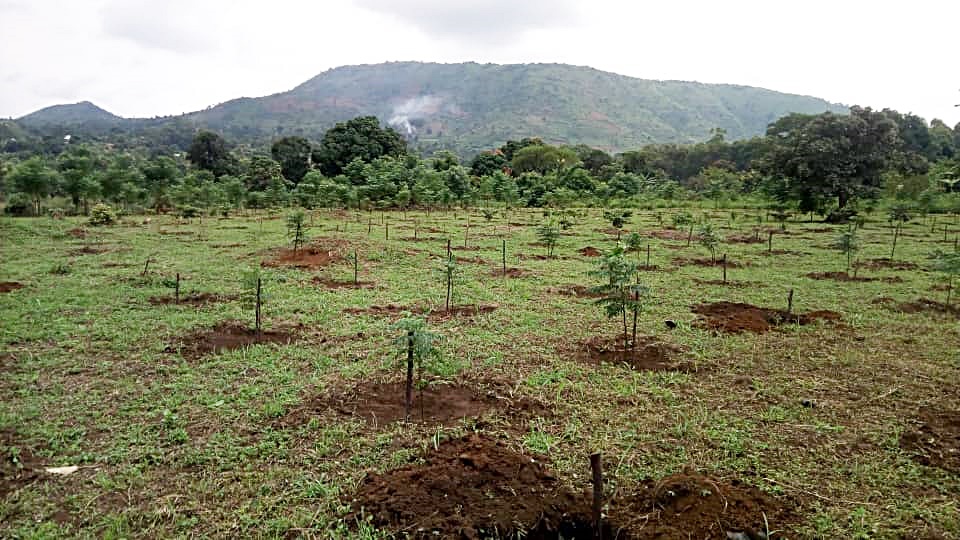
Clement Okia: Uganda has made excellent progress thanks to the Saw-log Production Scheme but what we need to achieve is large-scale restoration of forest and degraded landscapes. Uganda has committed to restore 2.5 million hectares under the Bonn Challenge and the Africa Forest Restoration Initiative. We can’t do that only through plantations and woodlots; we need to involve almost every farmer, through a landscape approach. Even if every farm has only a few trees, at the landscape level it will be a huge contribution. We have demonstrated this in communities we have worked with for some years. In some countries, they have guided that every farm should have 5–10% of its area covered with trees; they can be in different arrangements, such as lines, blocks or scattered. This can be a quicker way to achieve restoration if the right incentives are provided. By the early 2000s, 70% of trees in Uganda were reported to be growing outside forests and national parks. Sadly, about 40% of those trees were also reported to have been lost by 2015. Uganda cannot effectively protect its forests and parks once all trees on farms are lost.
We also can see that a national agroforestry strategy is necessary. There is some coverage of the concept embedded in the National Forest Policy and National Forestry and Tree Growing Act, referred to as ‘farm forestry’. We have no problem with what it’s called as long as it will support farmers to grow trees. We are encouraging the Government to make progress on this; we can learn from other countries. Any strategy to promote farm forestry to farmers at a large scale across the whole country needs to be conducted in a coordinated and well-planned manner, otherwise it won’t succeed; Uganda won’t meet its restoration commitments and will be more exposed to climate extremes and food insecurity.
Farm forestry should not only be limited to the Ministry of Water and Environment. It is cross-sectoral and requires active involvement of the Ministry of Agriculture, Animal Industries and Fisheries, Ministry of Local Government and Ministry of Lands, among others. Bringing the relevant ministries and agencies together through an appropriate coordination mechanism will be the key to ensuring we can help farmers grow more trees on their farms.
Guidelines are also needed on how agroforestry can be promoted in the different agro-ecological zones of the country, bringing together biodiversity and restoration of degraded landscapes that the Government has committed to supporting.
Regarding this, Uganda has used the Restoration Opportunities Assessment Methodology that was developed by the International Union for Conservation of Nature (IUCN) and the World Resources Institute. The Forest Sector Support Department worked with IUCN to develop the assessment for Uganda that showed that there were about 8.1 million hectares needing restoration in the seven agro-ecological zones.
They also had to consider the costs of restoration. Yet they’ve only done this so far for one zone and the costs were huge; where is Uganda going to find the money to do it? Smallholders growing trees in their own ways with a mixture of species can achieve landscape restoration at a cheaper cost. It’s time to marshal the huge number of smallholders and provide them with the necessary incentives — regulatory and financial — that will allow them to restore Uganda, for the benefit of the present and future generations.
Editor’s note: This interview has been edited for readability.

This project is part of the International Climate Initiative (IKI). The Federal Ministry for the Environment, Nature Conservation and Nuclear Safety (BMU) supports this initiative on the basis of a decision adopted by the German Bundestag.

